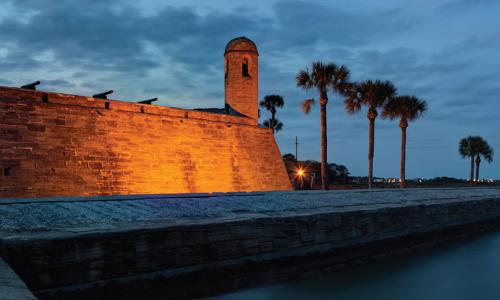This profile is excerpted from the 2014 report, National Landmarks at Risk: How Rising Seas, Floods, and Wildfires Are Threatening the United States' Most Cherished Historic Sites."
Few cities in the United States boast as many historic distinctions as St. Augustine, FL, but its illustrious past and coastal location come at a price. The low-lying city is prone to flooding, storm surges, and erosion. And its aging infrastructure takes a beating even in light rainstorms, with nuisance flooding regularly closing streets in the historic districts.
St. Augustine is the oldest city in the nation and home to the first port built in the United States, the country’s earliest Catholic parish, and the oldest masonry fort. Many of the city’s buildings are listed on the National Register of Historic Places, with some designated as landmarks worthy of special preservation.
The ethnic history of St. Augustine goes back a long way as well. The city holds special meaning for people of Hispanic heritage because it was founded as a Spanish military base in 1565 and was the seat of Spanish rule in North America for the next 200 years. In the late seventeenth century, the government of Spain began granting freedom to people escaping slavery in British colonies to the north, which enabled the first free African-American settlement in North America at Fort Mose, just north of St. Augustine. Following the Civil War, formerly enslaved people settled in what later came to be known as the city’s Lincolnville Historic District.
Because sea level rise in response to rising temperatures is worsening coastal flooding, storm surges, and erosion, Lincolnville and most of St. Augustine’s other historic districts are now particularly vulnerable, as they generally are at lower elevations than other parts of the city. Already, the Atlantic Ocean along Florida’s northeastern coast, where St. Augustine is located, has risen by about eight inches since 1930.
Sea level rise could significantly compromise the future of St. Augustine’s unique cultural heritage. For example, a rise of three feet, which is well within current projections, could permanently inundate portions of the city’s historic districts. Meanwhile, storm surges and flooding could undermine the foundations of many historic buildings unless protections are put in place.
Many of the oldest buildings in St. Augustine are constructed with coquina, an early form of concrete made from shells. A prime example of coquina construction is the Castillo de San Marcos, a waterfront fort dating from the seventeenth century, which is now a national monument. Bordering the 20-acre fort is a nineteenth-century coquina seawall that protects the downtown from flooding, but the ocean waves’ pounding of the wall during tropical storms has caused its deterioration and created the need for reinforcement. In 2011, the National Park Service built a “living” seawall. Over time, sediment will build up in front of the wall, and marine life and vegetation will establish themselves there, protecting the historic seawall from erosion and creating a natural habitat.
Heritage tourism, attracting more than 5 million visitors a year, contributes substantially to St. Augustine’s economic well-being.
To boost tourism yet further, work was recently completed on a $16-million project to maintain St. Augustine Beach by adding sand to the eroded shoreline—part of a 50-year commitment by the Army Corps of Engineers to keep it replenished.
Efforts at coastal adaptation in St. Augustine go back centuries to the time of Spanish rule, but rapidly rising sea levels pose new challenges as the city approaches its 450th anniversary in 2015 and faces an uncertain future. It is possible, for example, that at some point in that future (not too many years from now), parts of St. Augustine could no longer be habitable, and this might come as a rude awakening to many of its residents. “People in St. Augustine don’t realize they are vulnerable because the government has taken action to keep flooding out,” says Kathryn Frank, professor of urban and regional planning at the University of Florida. “But the increasing pace of sea level rise could likely overwhelm our ability to stay there.”




